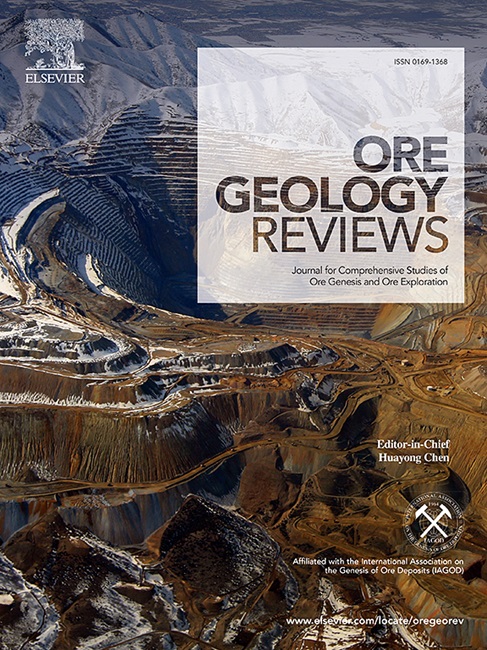IF 3.2
2区 地球科学
Q1 GEOLOGY
引用次数: 0
摘要
世界上许多主要的岩浆型镍铜钴硫化物矿床都出现在大陆洪积玄武岩的岩浆管道系统中。下马垅黑云母-超黑云母侵入体(∼291 Ma)与中国西南部的保山晚古生代大陆洪积玄武岩有关,蕴藏着岩浆分异在岩浆垂管系统中硫化物成矿作用的重要信息。我们通过比较夏麦地侵入体和大雪山岩浆镍铜钴硫化物矿床的岩石学和地球化学特征来解决这个问题。大雪山矿床的岩浆岩-超基性侵入体(∼301 Ma)也与宝山玄武岩有关。两个侵入体的橄榄石Fo含量相重叠(72-83 mol%),但下马垅侵入体的橄榄石Fo含量略低。霞麦地侵入岩橄榄石的镍含量相对较低(∼600-1300 ppm),且与萤石含量无相关性,表明该侵入体的形成涉及多个母岩浆脉冲。下马垅侵入岩中的铂族元素含量比已报道的宝山玄武岩中的铂族元素含量低约一个数量级。下马垅侵入岩和大雪山矿床的铜/钯比值相近,均明显高于宝山玄武岩(0.77×104~4.0×104),表明这两个侵入体的母岩在更深的地方经历了早期硫化物偏析。与宝山玄武岩相比,夏麦地和大雪山侵入岩的Nb-Ta负异常较大,εNd(t)值(-5.7至-7.9)较低,(87Sr/86Sr)i比(0.7111至0.7135)高于玄武岩的平均成分[εNd(t)=-1.9;(87Sr/86Sr)i=0.7073]。侵入岩的母岩主要来自次大陆岩石圈地幔,而洪积玄武岩则主要来自下伏地幔羽流。据估计,夏麦地和大雪山侵入岩的母岩浆中地壳污染的含量从15%到30%不等。全岩Sr-Nd同位素和痕量元素数据支持母岩浆中硫化物饱和主要由地壳污染引起的观点。本研究对镍矿勘探最重要的启示是:(1)在侵入体尺度上,未来勘探的重点应放在下马垅和大雪山侵入系统的赋存体上;(2)在区域尺度上,含萤石含量高于下马垅超基性岩的橄榄岩的超基性侵入体是宝山区块最有利的勘探目标。本文章由计算机程序翻译,如有差异,请以英文原文为准。

Petrological and geochemical studies of the Xiamaidi mafic–ultramafic intrusion in the Baoshan block, with implications for Ni exploration
Many major magmatic Ni-Cu-Co sulfide deposits worldwide occur in the magma plumbing systems of continental flood basalt. The Xiamaidi mafic–ultramafic intrusion (∼291 Ma) is associated with the Baoshan Late Paleozoic continental flood basalts in southwestern China and hosts important information about the role of magma differentiation in sulfide mineralization in the magma plumbing systems. We address this question by comparing the petrological and geochemical features between the Xiamaidi intrusion and the Daxueshan magmatic Ni-Cu-Co sulfide deposit. The Daxueshan deposit is hosted by a mafic–ultramafic intrusion (∼301 Ma) that is also associated with the Baoshan basalts. The olivine Fo contents of in both intrusions overlap (72–83 mol%), but the Xiamaidi intrusion tends to have slightly lower olivine Fo contents. The olivine of the Xiamaidi intrusive rocks is relatively depleted in Ni (∼600–1300 ppm) and shows no correlation with Fo contents, indicating that multiple pulses of parental magma were involved in the formation of this intrusion. The contents of platinum group elements (PGE) in the Xiamaidi intrusive rocks are about one order of magnitude lower than in the reported Baoshan basalts. The Cu/Pd ratios of the Xiamaidi intrusive rocks and the Daxueshan deposit are similar and are all significantly higher than the ratios of the Baoshan basalts (0.77 × 104 to 4.0 × 104), indicating that the parental magmas for both intrusions had experienced early sulfide segregation at greater depths. Compared to the Baoshan basalts, the Xiamaidi and Daxueshan intrusive rocks have larger negative Nb-Ta anomalies, lower εNd(t) values (–5.7 to –7.9) and higher (87Sr/86Sr)i ratios (0.7111 to 0.7135) than the average compositions of the basalts [εNd(t) = –1.9; (87Sr/86Sr)i = 0.7073]. The differences can be explained by different mantle sources plus variable crustal contamination, with the parental magmas for the intrusive rocks derived predominantly from a subcontinental lithospheric mantle whereas the flood basalts derived mainly from the underlying mantle plume. The estimated amounts of crustal contamination in the parental magmas for the Xiamaidi and Daxueshan intrusions vary from 15 to 30 wt%. The whole-rock Sr-Nd isotopic and trace elemental data support the view that sulfide saturation in the parental magmas was mainly induced by crustal contamination. The most important implications for Ni exploration from this study are (1) at an intrusion scale, future exploration should focus on the feeders of the Xiamaidi and Daxueshan intrusive systems, and (2) at a regional scale, the ultramafic intrusions containing olivine with higher Fo contents than that in the Xiamaidi ultramafic rocks are the most favorable exploration targets in the Baoshan block.
求助全文
通过发布文献求助,成功后即可免费获取论文全文。
去求助
来源期刊

Ore Geology Reviews
地学-地质学
CiteScore
6.50
自引率
27.30%
发文量
546
审稿时长
22.9 weeks
期刊介绍:
Ore Geology Reviews aims to familiarize all earth scientists with recent advances in a number of interconnected disciplines related to the study of, and search for, ore deposits. The reviews range from brief to longer contributions, but the journal preferentially publishes manuscripts that fill the niche between the commonly shorter journal articles and the comprehensive book coverages, and thus has a special appeal to many authors and readers.
 求助内容:
求助内容: 应助结果提醒方式:
应助结果提醒方式:


